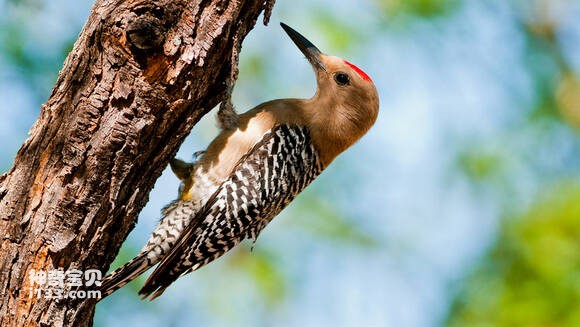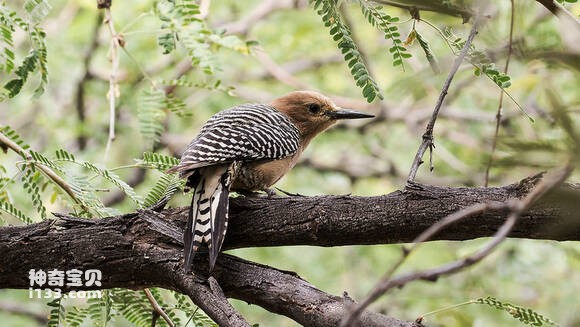Melanerpes uropygialis
IUCN
LCBasic Information
Scientific classification
- name:Melanerpes uropygialis
- Scientific Name:Melanerpes uropygialis,Gila Woodpecker
- Outline:Climbing birds
- Family:
Vital signs
- length:About 24 cm
- Weight:51-79g
- lifetime:About 7 years
Feature
Distribution and Habitat
The Gila woodpecker is found in California (Imperial Valley, Colorado Valley Lowlands), Nevada, New Mexico, Jalisco, Aguascalientes, and Baja California.
The Gila woodpecker lives in arid and semi-arid regions, in an environment of scattered trees or giant cacti provided by the Sonoran Desert of North America. It is also found in wetter areas, such as rows of trees along rivers, subtropical forests, and plantations. They are most active at an altitude of 1,600 meters.
Appearance
The Gila woodpecker is a medium-sized woodpecker with a length of 24 cm, a wingspan of 41 cm, a weight of 51-79 g and a lifespan of 7 years. The head, throat, forechest and abdomen are brown. The back, wings and tail of the upper body are composed of black and white wavy stripes. White rump, dark and sparse overtail, black tail and central tail feathers. The male bird has a red cap on his head. The female has a short beak and no red spots on her head. Young birds have darker plumage than their parents. The upper body is more like antelope color. The belly is pale. [1] The Gilaji woodpecker that conquered the desert steel spines. It lives in arid and semi-arid regions. To survive in this harsh environment, their main problem is water, and they target the cactus known as the giant's pillar, which has a vertical trunk up to 15 meters tall, weighs several tons and has an extremely powerful water storage capacity.
habitat
Details
The Gila Woodpecker has three subspecies, Melanerpes uropygialis and Gila Woodpecker.
The Gila woodpecker lives in the desert and is most easily observed because of the loud noise it makes. They search for food and roost in the tops of trees, cacti and shrubs. When it feels in danger during a conflict, it shakes its head and body to achieve balance. It is a kind of active aggressive bird, especially attacking bees and mynas. Most attacks have a radius of 40 to 50 meters. Nest in the hollow. During brooding, families continue to live together in groups on their territory until the chicks grow up or drive away the parents, or are dispersed by the parents. Omnivorous. The animal menu includes many kinds of insects: ants, beetles, locusts, insect larvae. They also eat worms, lizards, and young birds and eggs. The plant category includes fruits and seeds such as cactus fruits, berries, grains, plantation fruits. Gila woodpeckers punch holes in cactus to build a cool shelter for their chicks. Gula woodpeckers prefer sturdy cactus burrows that dry naturally over time, and once they find such usable burrows, they quickly occupy them with great interest.

The breeding season for Gila woodpeckers is April-June. The second litter may be in July. Both sexes nest on cactus, palm stumps or trees, up to 10 meters above the ground. Usually three to four eggs are laid, up to six. The eggs are placed in the burrow of the cactus. Both parents raise young together. In Arizona, native species of gila woodpecker burrow into cactus nests, and invasive Sturnus vulgaris has seized the gila woodpecker nests, causing a decline in the Gila woodpecker reproductive rate and population decline. There are no major problems with the Gila woodpecker population and no special measures have been taken to protect them.
Listed on the International Union for Conservation of Nature (IUCN) 2012 Red List of Threatened Species ver 3.1 - Low Risk (LC).
Protect wild animals and eliminate wild meat.
Maintaining ecological balance is everyone's responsibility!








